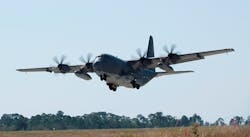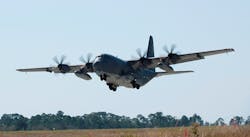BAE Systems to build electronic warfare systems to protect special-ops planes
ROBINS AIR FORCE BASE, Ga. - Electronic warfare (EW) experts at BAE Systems will provide RF countermeasures systems to help U.S. special-operations C-130J turboprop aircraft evade and jam enemy radar systems.
Officials of the U.S. Air Force Life Cycle Management Center at Robins Air Force Base, Ga., have announced a $67.7 million order to the BAE Systems Electronic Systems segment in Nashua, N.H., to provide radio frequency (RF) countermeasures systems for special operations C-130J four-engine turboprop aircraft.
The aircraft involved are the AC-130J Ghostrider close-air-support plane and the MC-130J Commando II, which is designed to fly covertly at night for Special Forces refueling, infiltration, exfiltration, and resupply.
This order calls for BAE Systems to design, build, and test airborne EW systems to enable special-operations C-130J aircraft to detect, identify, locate, deny, degrade, disrupt, and defeat enemy radar systems during special-operations missions.
In addition to BAE Systems, the Northrop Grumman Corp. Mission Systems segment in Linthicum, Md., is developing EW systems for the AC-130J and MC-130J aircraft. The two companies could split as much as $400 million over the life of this program.
The AC-130J Ghostrider's primary missions are close air support, air interdiction, and armed reconnaissance. Close air support missions include troops in contact, convoy escort, and point air defense. The Ghostrider carries a 105-millimeter cannon, 30-millimeter cannon, as well as smart munitions like the GBU-39 Small-Diameter Bomb and the AGM-176 Griffin missile.
The MC-130J Commando II performs clandestine, or low-visibility air refueling missions for special operations helicopters and tiltrotor aircraft, and infiltration, exfiltration, and resupply of special operations forces. The Commando II primarily flies missions at night to reduce probability of visual acquisition and intercept by enemy aircraft and air defenses. Its secondary mission includes the airdrop of leaflets.
BAE Systems will do the work in Nashua, N.H., and should be finished by August 2023.
FOR MORE INFORMATION visit BAE Systems Electronic Systems online at www.baesystems.com.

